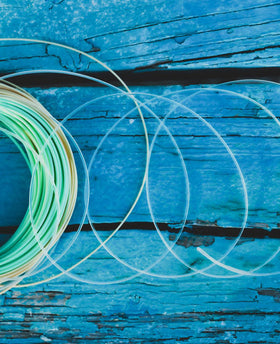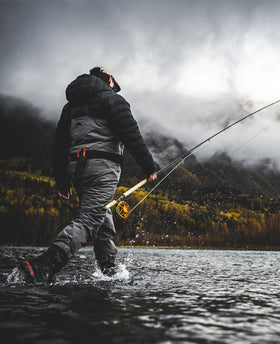
FALL: The Best Season To Be On The Water
There’s a strange phenomenon that occurs in the fishing community every year. Air temperatures get a little cooler and a good portion of the anglers out there are nowhere to be found. I understand why the summer is the most fished season. There's wonderful weather, kids are out of school so it’s the perfect time to travel, dry fly hatches are excellent, and so much more. But, the fall season is truly when fishing is at its best. In this article, we’re going to take a look at why fall fishing is so incredible, as well as some of the opportunities available during this season.

As the air begins to get colder each week, so do the water temperatures. This may seem like a no-brainer, but in a state where tailwaters are the primary fishing destination, it’s often a factor that is overlooked. Cooler water temperatures directly result in an increase in trout activity, as the ideal temperature for trout is roughly 52 degrees Fahrenheit. In water this cold and colder, oxygen levels are incredibly high, allowing for the trout to increase activity without causing stress or mortality. Throughout our summer months, there are only a few locations where water temperatures this cold are present. Most of the time the average temperature throughout the summer is anywhere from 60-67 degrees Fahrenheit. High temperatures dramatically decrease the level of oxygen in the water.
Unfortunately, this cooler water with higher oxygen comes as a double-edged sword. Cooler temperatures means less bug activity, as well as the freezing of our freestones and stillwaters. Fishing isn’t going to be quite the same, but that’s a good thing. Trout know that food is going to quickly disappear and that ice will be covering their heads, so they decide to start eating a lot more to pack on some weight.
Trying to catch these fish can be done two ways, nymphing and streamer fishing. Nymphing with a big attractor followed by one or two BWO or midge imitations is a great way to go about this. Trout are fairly pressured in Colorado, so still tying on the tiny stuff goes a long way. That being said, those high caloric food items such as stoneflies, eggs (we’ll talk about this more in a bit), leeches, and worms will entice many fish, particularly bigger fish that need to eat more to sustain themselves. Streamer fishing can also be red hot, fish know that bigger prey hold a lot of nutrients. Eating larger meals such as crawfish, sculpins, baby trout, and other baitfish species are great ways for trout to put on some weight. Fall is so good for streamers that many people throw streamers only in the fall.

It’s important to note that trout, particularly brown and brook trout, aren’t eating streamers just for the caloric value. Fall is the spawning season for brown and brook trout, which means an increased level of aggression in these fish. Oftentimes these fish aren’t necessarily eating the streamers as a meal, but to remove a threat from their territory. 
In the coming weeks we’ll begin to see the formation of spawning beds, often called redds. During the spawn, fish that choose to reproduce do not eat until “the job” is done, which means that they’re in a decreased state of health. Pulling them off the redd, making them fight, and handling them often results in a dead fish. This means one less fish reproducing and helping sustain our amazing rivers. So by all means do not fish for any fish on redds, I repeat DO NOT FISH REDDS. Redds can be identified as clean patches of gravel in relatively shallow areas, typically in riffles.
The spawning period is why throwing an egg is such an effective tactic in the fall. Non-spawning species will key in on them as the influx of eggs within the river makes it hard to pass up. Not only that, but brown and brook trout will eat eggs to fuel themselves throughout the spawn, but to mainly destroy a competitor's offspring. Good egg colors can vary, throwing an orange, red, or peach is always a safe bet, but dead egg colors such as chartreuse and pale pinks can pick up more eats.

Looking away from our spawners and the fish that have to deal with an icy winter, our local tailwaters fish incredible every fall. Early fall, depending on conditions, can have BWO’s, tricos, and PMD’s all in the same day. This doesn’t happen often, but it occurred this year which created some incredible dry fly days on the South Platte. Now we’ve moved on from this timeframe and are currently fishing like a standard fall. BWO’s are hatching in clouds right now throughout the state, but particularly in areas like the South Platte, Blue, and Williams Fork. For some reason, trout love to eat BWO’s and will choose them over many other bugs that are currently hatching. This can result in some of the best dry fly fishing all year. The only downside to the fall hatch of BWO’s is that they’re two sizes smaller than their spring counterparts. The spring hatches average a size 18 or 20, whereas the fall hatches are a size 22 or 24.
The fall also brings the infamous kokanee salmon to some of our rivers. They aren’t going to eat your dry fly or chase down your streamer, but they do offer a chance at a different species that we can’t get all year. Huge pods of kokanee stage up in deeper runs and pools before moving upstream. These fish, with the right nymphing presentation, are willing to eat bright and large flies that come their way. Eggs, worms, perdigons, and copper johns in red, pink, chartreuse, and orange will get you plenty of eats.

I could go on and on about fall fishing, but instead of reading my gibberish, you should go out there and enjoy it! I hope this article helped and if you have any questions about fall fishing, feel free to email Xavier at xavier@goldenflyshop.com, or call the shop at 303-330-1292.




Leave a comment